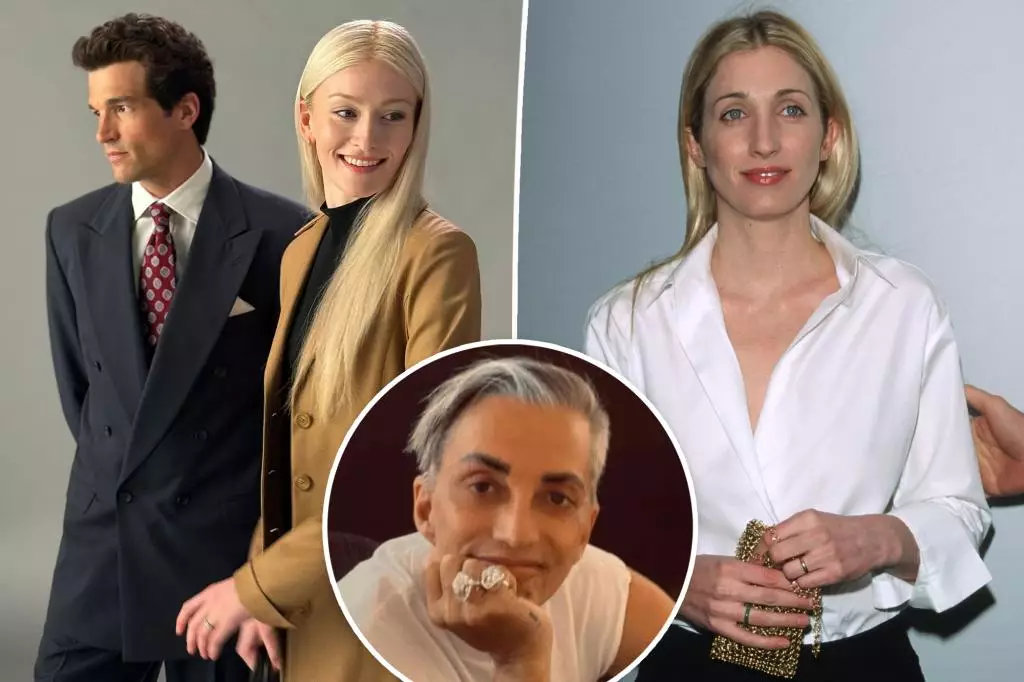As the world gears up for Ryan Murphy’s latest FX series, “American Love Story,” excitement and skepticism swirl around the portrayal of one of the most iconic couples of the 20th century: Carolyn Bessette-Kennedy and John F. Kennedy Jr. The initial images released from the production sparked immediate controversy, particularly regarding the depiction of Carolyn’s style—an element that has defined her legacy for decades. Fans of Bessette-Kennedy took to social media, expressing their discontent over the initial costume design, which they felt failed to honor her iconic image rooted in high fashion and sophistication.
The stills feature actress Sarah Pidgeon as Carolyn, but while her physical resemblance might evoke comparisons, the nuanced essence of Carolyn’s style left many yearning for a more authentic representation. Carolyn was not just a woman of celebrity; she was a publicist for Calvin Klein and an enduring style icon who embodied the ethos of understated elegance with a contemporary edge. This instance raises the question: How crucial is authenticity in representation, especially for someone whose style has inspired generations?
Expert Insights and Critical Observations
Intriguingly, the key to understanding Carolyn’s true style lies in her relationship with hair colorist Brad Johns. Known for his innovative “chunking” technique, Johns played an instrumental role in crafting the stunning blonde shades that Carolyn was famous for. When he observed the first look shared by Murphy’s team, his reaction was not merely one of disappointment; it was a visceral response by someone who had a vivid, intimate relationship with Bessette-Kennedy.
Johns described the look as incorrect, citing that Carolyn’s hair was neither burnt nor ashy, but rather a balanced blend of gold tones that radiated warmth and vitality. The contrast between Johns’ recollections and the production’s portrayal underscores a deeper critique of Hollywood: the struggle for genuine representation and a tendency towards caricature. In an era where the call for authenticity in storytelling has never been louder, it’s disheartening when the character’s appearance strays from the truth.
Moreover, the use of wardrobe items in the initial release, such as the chosen Hermès Birkin bag and camel overcoat, elicited criticism as observers noted that these props did not encapsulate Carolyn’s quintessential aesthetic. The connection between fashion and identity is profound, and for Carolyn, her clothing and accessories were emblematic of her sophistication and sense of self. This dissonance between reality and dramatization can incite valid questions about the respect given to cultural icons within media.
The Response from Ryan Murphy
Addressing the backlash, Ryan Murphy sought to reassure fans, mentioning that the released images were merely test shots and that the costumes were still undergoing refinement. He explained that the initial visuals were never intended as definitive representations but rather as placeholders to aid the studio’s direction. This points to an ongoing dilemma in television production, where the need for quick previews sometimes clashes with the yearning for thoughtful and meticulous portrayals.
Furthermore, Murphy’s promise to invite fashion bloggers dedicated to Carolyn’s legacy for a behind-the-scenes glimpse at the transformation in costumes indicates a proactive approach to address concerns and incorporate authentic feedback. This decision highlights the importance of community engagement in modern storytelling, where the fans of characters are often the most vocal guardians of their legacies.
Incorporating unique pieces that Carolyn was known to wear, from vintage Prada to moments of Calvin Klein elegance, offers the production team an opportunity to pay tribute to the beloved icon in a meaningful way. By understanding the essence of her style—ensuring that it reflects both the era and the personal story—Murphy seeks to propel Carolyn’s narrative forward in a manner that resonates with both historical truth and contemporary believers in her style.
A Moment of Reflection
In looking at Carolyn Bessette-Kennedy’s life, particularly her ethereal connection to fashion, it’s evident that she represented more than just a celebrity figure. She embodied an era—the ’90s—when individuality was celebrated through fashion that whispered rather than shouted. This balancing act between public and private life gives immense weight to the portrayal of her character in “American Love Story.”
In a world where portrayal matters now more than ever, one cannot help but hope for an adaptation that understands and respects the scalp beneath the strands, the essence beneath the fabric. Carolyn Bessette-Kennedy was not merely an aesthetic; she was a narrative woven through moments of grace and authenticity, demanding nothing less than an equally respectful portrayal in this new chapter of her story.

